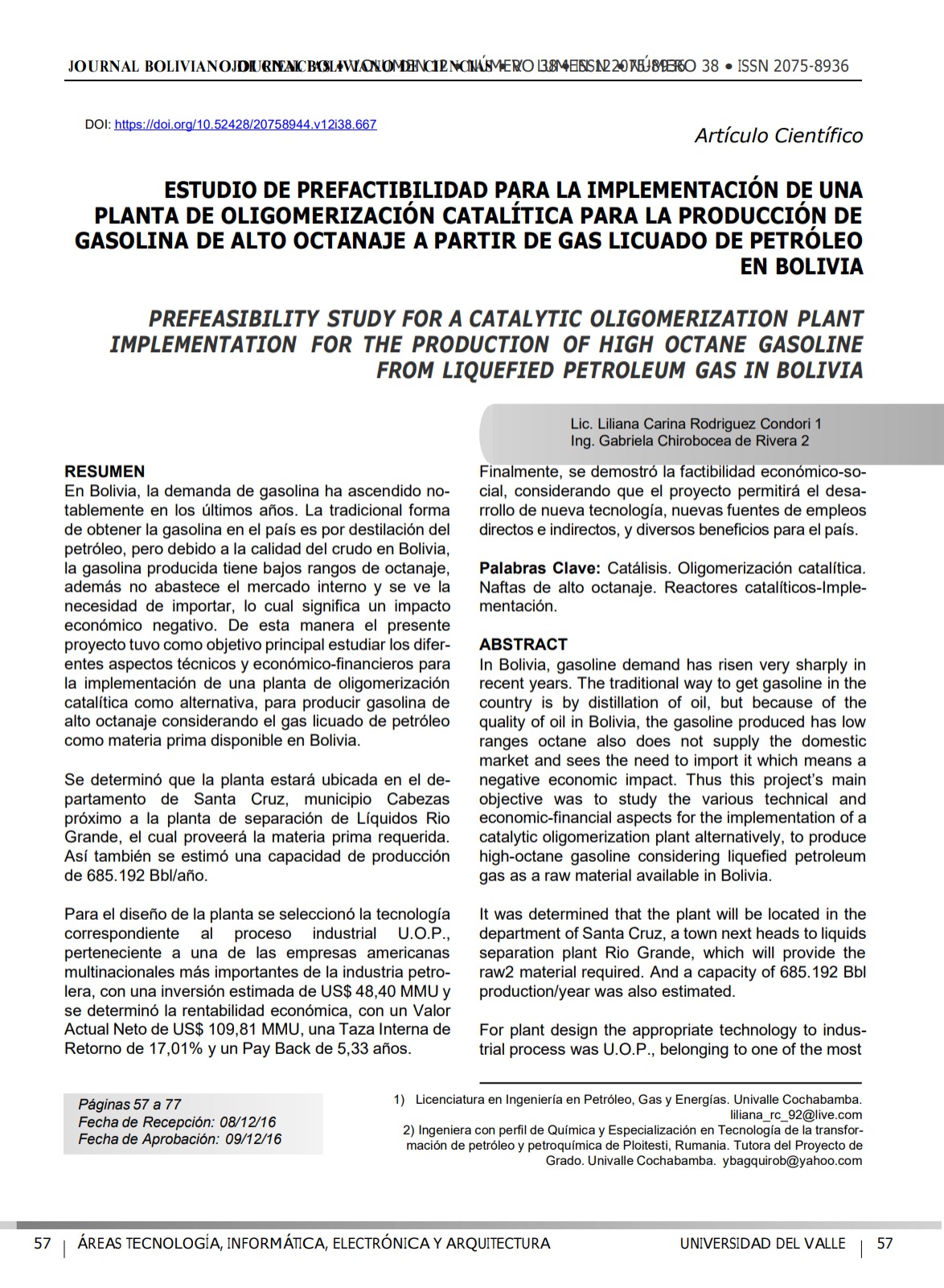Prefeasibility Study for a Catalytic Oligomerization Plant Implementation for the Production of High Octane Gasoline from Liquefied Petroleum Gas in Bolivia
DOI:
https://doi.org/10.52428/20758944.v12i38.667Keywords:
Catalysis, Catalytic oligomerization, High octane naphthas, Catalytic Reactors-ImplementationAbstract
In Bolivia, gasoline demand has risen very sharply in recent years. The traditional way to get gasoline in the country is by distillation of oil, but because of the quality of oil in Bolivia, the gasoline produced has low ranges octane also does not supply the domestic market and sees the need to import it which means a negative economic impact. Thus this project's main objective was to study the various technical and economic-financial aspects for the implementation of a catalytic oligomerization plant alternatively, to produce high-octane gasoline considering liquefied petroleum gas as a raw material available in Bolivia. lt was determined that the plan! will be located in the department of Santa Cruz, a town next heads to liquids separation plant Rio Grande, which will provide the raw2 material required. And a capacity of 685.192 Bbl production/year was also estimated. For plant design the appropriate technology to industrial process was U.O.P., belonging to one of the most important American multinational companies in the oil industry, it was selected with an estimated US$ 248,40 MUS investment and economic profitability was determined, with a net present value of US$ 1 0 9 , 8 1 MUS, an interna! rate of return of 1 7 , 0 1 % and Pay Back of 5,33 years. Finally, the economic and social feasibility was demonstrated considering that the project will enable the development of new technology, new sources of direct and indirect jobs and various benefits for the country.
Downloads
References
(1) RAMALLO, A. PREPARACIÓN, Evaluación y Administración de Proyectos de Inversión; Editorial Latinas; 2009.
(2) Anuario estadístico de producción, transporte, refinación, almacenaje y comercialización de hidrocarburos, correspondientes a las gestiones 2009, 201 O, 2011 y 2012, publicado por el Ministerio de Hidrocarburos y Energía.
(3) Boletín estadístico, publicado por Yacimientos Petrolíferos Fiscales Bolivianos, correspondientes a las gestiones 2011, 2012, 2013, 2014.
(4) Cifras del comercio exterior boliviano, correspondientes a las gestiones 2009, 201 O, 2 0 1 1 , 2012, 2013, 2014, publicado por Instituto Boliviano de Comercio Exterior junto con el Instituto Nacional de Estadística.
(5) SAPAG, N. Y SAPAG, R. Preparación y evaluación de proyectos. México; MCGRAW-HILL; 2003.
(6) Proyecto de Plan Municipal de Ordenamiento Territorial Cabezas (MASRENA GTZ/IP). en es.slideshare.net/doctora_edilicia/070703-cabezas (23 de agosto de 2015).
(7) WUITHIER, P. Refino de Petróleo y Tratamiento Químico. Tomo 11; Madrid; Ediciones Cepsa S.A.; 1971.
(8) PETER, M., & TIMMERHAUS, K. PLANT Design and Economics for Chemical Engineers. 5a ed. Estados Unidos; McGRAW-HILL; 2003.
(9) ARBOLEDA, J. Manual de evaluación de impacto ambiental de proyectos, obras o actividades. Colombia; Medellín; 2008.
(10) CERUTTI, A., (2002). Refinación del Petróleo. (Tomo 11). Argentina: IAPG.

Downloads
Published
How to Cite
Issue
Section
License
Copyright (c) 2016 Liliana Carina Rodriguez Condori y Gabriela Chirobocea de Rivera

This work is licensed under a Creative Commons Attribution 4.0 International License.
Authors who publish with this journal agree to the following terms:
- Authors retain copyright and grant the journal right of first publication with the work simultaneously licensed under a Creative Commons Attribution License 4.0 that allows others to share the work with an acknowledgement of the work's authorship and initial publication in this journal.
- Authors are able to enter into separate, additional contractual arrangements for the non-exclusive distribution of the journal's published version of the work (e.g., post it to an institutional repository or publish it in a book), with an acknowledgement of its initial publication in this journal.
- Authors are permitted and encouraged to post their work online (e.g., in institutional repositories or on their website) prior to and during the submission process, as it can lead to productive exchanges, as well as earlier and greater citation of published work.














